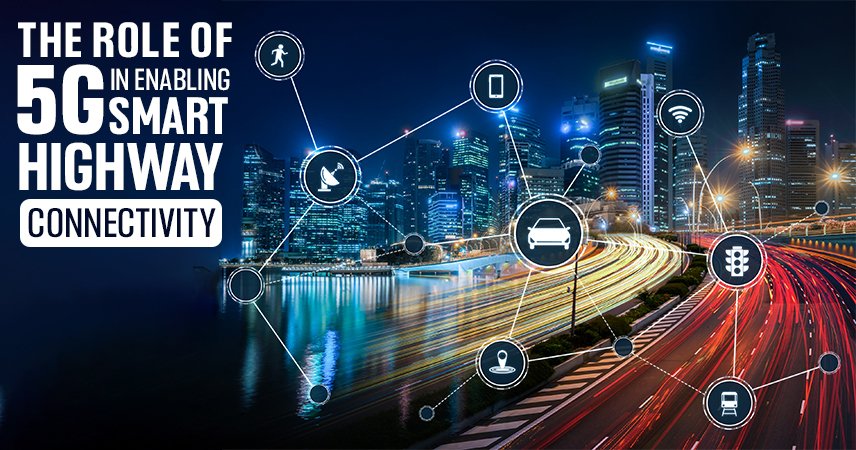The Role of 5G in Enabling Smart Highway Connectivity

The advent of 5G technology marks a significant milestone in the evolution of wireless communication, promising unprecedented speeds, low latency, and massive connectivity. One of the most transformative applications of 5G is its potential to revolutionize transportation, particularly through the development of smart highways. These highways, embedded with advanced technology, aim to enhance safety, efficiency, and sustainability in road transportation. This blog explores the crucial role of 5G in enabling smart highway connectivity and the benefits it brings to the future of transportation.
What Are Smart Highways?
Smart highways are roadways integrated with cutting-edge technologies that enable real-time communication between vehicles, infrastructure, and road users. These highways leverage sensors, cameras, and Internet of Things (IoT) devices to collect and share data, facilitating intelligent transportation systems (ITS). The data collected is used to improve traffic management, enhance road safety, and reduce environmental impact. The core of smart highway functionality relies heavily on robust and reliable communication networks, making 5G a key enabler of these systems.
The Benefits of 5G for Smart Highways
- Enhanced Communication and Data Exchange
5G’s high-speed connectivity and low latency enable seamless communication between vehicles (V2V), infrastructure (V2I), and pedestrians (V2P). This real-time data exchange is critical for applications such as collision avoidance, traffic signal timing, and dynamic traffic management. For instance, vehicles can instantly communicate their position, speed, and direction to each other and to roadside units, preventing accidents and optimizing traffic flow.
- Improved Traffic Management
Smart highways equipped with 5G can leverage real-time traffic data to optimize traffic light signals, manage congestion, and reroute vehicles in case of accidents or roadblocks. This dynamic traffic management reduces travel time, lowers fuel consumption, and minimizes emissions, contributing to a more sustainable transportation system.
- Enhanced Safety Features
5G enables advanced safety features such as autonomous driving and connected vehicle technology. Autonomous vehicles rely on real-time data to navigate safely and efficiently. With 5G, these vehicles can communicate with each other and with infrastructure, enhancing their ability to make split-second decisions and reducing the likelihood of accidents. Additionally, 5G supports emergency response systems by providing real-time information on accidents, enabling quicker and more effective interventions.
- Predictive Maintenance
Smart highways equipped with 5G can monitor the condition of road infrastructure and vehicles in real-time. Sensors embedded in the road surface can detect wear and tear, while vehicle diagnostics can predict maintenance needs. This predictive maintenance helps prevent road damage and vehicle breakdowns, improving overall road safety and reducing maintenance costs.
- Enhanced User Experience
5G enhances the overall driving experience by enabling high-speed internet access for passengers, providing real-time navigation updates, and supporting infotainment systems. Travelers can enjoy uninterrupted streaming, access to real-time traffic information, and enhanced in-car entertainment, making long journeys more enjoyable and productive.
Challenges and Considerations
While the benefits of 5G-enabled smart highways are substantial, several challenges need to be addressed for widespread implementation:
- Infrastructure Investment
The deployment of 5G infrastructure requires significant investment in terms of both time and money. Building the necessary network of small cells, fiber optics, and edge computing facilities is a massive undertaking that requires collaboration between governments, telecom operators, and private sector stakeholders.
- Cybersecurity Concerns
The increased connectivity and data exchange on smart highways raise cybersecurity concerns. Ensuring the security of data and protecting against cyber threats is crucial to maintaining the integrity and safety of smart highway systems.
- Regulatory and Standardization Issues
The development and implementation of smart highways require clear regulations and standards to ensure interoperability and safety. Governments and regulatory bodies must work together to establish guidelines that facilitate the safe and efficient deployment of smart highway technologies.
Conclusion
The role of 5G in enabling smart highway connectivity is transformative, offering numerous benefits in terms of safety, efficiency, and sustainability. As the technology continues to evolve, the integration of 5G into transportation infrastructure promises to revolutionize the way we travel, making roads smarter, safer, and more connected. While challenges remain, the potential of 5G-enabled smart highways to enhance the future of transportation is undeniable, paving the way for a smarter and more connected world.


